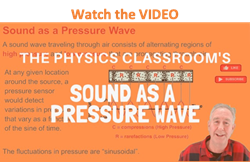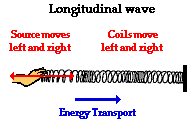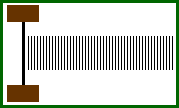Hold down the T key for 3 seconds to activate the audio accessibility mode, at which point you can click the K key to pause and resume audio. Useful for the Check Your Understanding and See Answers.
 In the first part of Lesson 1, it was mentioned that sound is a mechanical wave that is created by a vibrating object. The vibrations of the object set particles in the surrounding medium in vibrational motion, thus transporting energy through the medium. For a sound wave traveling through air, the vibrations of the particles are best described as longitudinal. Longitudinal waves are waves in which the motion of the individual particles of the medium is in a direction that is parallel to the direction of energy transport. A longitudinal wave can be created in a slinky if the slinky is stretched out in a horizontal direction and the first coils of the slinky are vibrated horizontally. In such a case, each individual coil of the medium is set into vibrational motion in directions parallel to the direction that the energy is transported.
In the first part of Lesson 1, it was mentioned that sound is a mechanical wave that is created by a vibrating object. The vibrations of the object set particles in the surrounding medium in vibrational motion, thus transporting energy through the medium. For a sound wave traveling through air, the vibrations of the particles are best described as longitudinal. Longitudinal waves are waves in which the motion of the individual particles of the medium is in a direction that is parallel to the direction of energy transport. A longitudinal wave can be created in a slinky if the slinky is stretched out in a horizontal direction and the first coils of the slinky are vibrated horizontally. In such a case, each individual coil of the medium is set into vibrational motion in directions parallel to the direction that the energy is transported.


Sound waves in air (and any fluid medium) are longitudinal waves because particles of the medium through which the sound is transported vibrate parallel to the direction that the sound wave moves. A vibrating string can create longitudinal waves as depicted in the animation below. As the vibrating string moves in the forward direction, it begins to push upon surrounding air molecules, moving them to the right towards their nearest neighbor. This causes the air molecules to the right of the string to be compressed into a small region of space. As the vibrating string moves in the reverse direction (leftward), it lowers the pressure of the air immediately to its right, thus causing air molecules to move back leftward. The lower pressure to the right of the string causes air molecules in that region immediately to the right of the string to expand into a large region of space. The back and forth vibration of the string causes individual air molecules (or a layer of air molecules) in the region immediately to the right of the string to continually vibrate back and forth horizontally. The molecules move rightward as the string moves rightward and then leftward as the string moves leftward. These back and forth vibrations are imparted to adjacent neighbors by particle-to-particle interaction. Other surrounding particles begin to move rightward and leftward, thus sending a wave to the right. Since air molecules (the particles of the medium) are moving in a direction that is parallel to the direction that the wave moves, the sound wave is referred to as a longitudinal wave. The result of such longitudinal vibrations is the creation of compressions and rarefactions within the air.

Regardless of the source of the sound wave - whether it is a vibrating string or the vibrating tines of a tuning fork - sound waves traveling through air are longitudinal waves. And the essential characteristic of a longitudinal wave that distinguishes it from other types of waves is that the particles of the medium move in a direction parallel to the direction of energy transport.
We Would Like to Suggest ...

Why just read about it and when you could be interacting with it? Interact - that's exactly what you do when you use one of The Physics Classroom's Interactives. We would like to suggest that you combine the reading of this page with the use of our
Simple Wave Simulator. You can find it in the Physics Interactives section of our website. The
Simple Wave Simulator provides the learner an environment to explore the distinction between longitudinal and transverse waves, the wavelength-frequency-period relationship, sound waves as pressure waves, and much more.